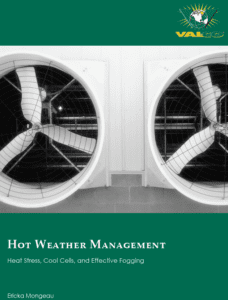Hot Weather Management

Poultry farmers are no strangers to extremes, especially extreme temperatures. Perfect growing conditions might only exist a few days out of the year, and the rest of the time is spent trying to manufacture the perfect environment. Peak summertime temperatures can be detrimental to flocks, so its imperative that effective cooling strategies are used. To do this well, first understand how bird’s naturally cope with heat stress, as well as, the relationship between heat and humidity.
Adult chickens are homeothermic, meaning they produce and dissipate heat to maintain a constant body temperature. The deep body internal temperature of a chicken ranges between 105-107°F (40.6-41.7°C) . They can withstand fluctuations fairly well, but their upper lethal limit is 113-117°F. If producers can keep chickens within, or as close as possible to, their thermoneutral zone, then productivity will remain relatively consistent. The comfort zone for poultry is about 90°F (32°C) at hatching, and it declines to 75°F (24°C) by four weeks of age, before leveling out.
Chickens can be fairly adaptable when it comes to heat stress. They lack functional sweat glands, but still manage their heat loss through circulation and respiration. Birds will first increase blood flow to the surface of the body in an attempt to lose heat to the air. They will often be seen lifting their wings to expose more body surface. When this proves inadequate, chickens resort to panting, where the cooling effect takes place in the lungs and airways as air is evaporated off the air sacs.
